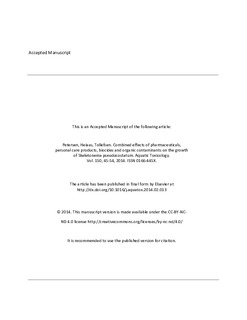| dc.contributor.author | Petersen, Karina | |
| dc.contributor.author | Heiaas, Harald | |
| dc.contributor.author | Tollefsen, Knut-Erik | |
| dc.date.accessioned | 2018-09-06T06:38:41Z | |
| dc.date.available | 2018-09-06T06:38:41Z | |
| dc.date.created | 2014-12-06T11:51:59Z | |
| dc.date.issued | 2014 | |
| dc.identifier.citation | Aquatic Toxicology. 2014, 150, 450-454. | nb_NO |
| dc.identifier.issn | 0166-445X | |
| dc.identifier.uri | http://hdl.handle.net/11250/2561075 | |
| dc.description.abstract | Organisms in the environment are exposed to a number of pollutants from different compound groups. Inaddition to the classic pollutants like the polychlorinated biphenyls, polyaromatic hydrocarbons (PAHs),alkylphenols, biocides, etc. other compound groups of concern are constantly emerging. Pharmaceuticalsand personal care products (PPCPs) can be expected to co-occur with other organic contaminants likebiocides, PAHs and alkylphenols in areas affected by wastewater, industrial effluents and intensiverecreational activity. In this study, representatives from these four different compound groups weretested individually and in mixtures in a growth inhibition assay with the marine algae Skeletonemapseudocostatum (formerly Skeletonema costatum) to determine whether the combined effects couldbe predicted by models for additive effects; the concentration addition (CA) and independent action(IA) prediction model. The eleven tested compounds reduced the growth of S. pseudocostatum in themicroplate test in a concentration-dependent manner. The order of toxicity of these chemicals wereirgarol > fluoxetine > diuron > benzo(a)pyrene > thioguanine > triclosan > propranolol > benzophenone3 > cetrimonium bromide > 4-tert-octylphenol > endosulfan. Several binary mixtures and a mixture ofeight compounds from the four different compound groups were tested. All tested mixtures wereadditive as model deviation ratios, the deviation between experimental and predicted effect concentrations, were within a factor of 2 from one or both prediction models (e.g. CA and IA). Interestingly, aconcentration dependent shift from IA to CA, potentially due to activation of similar toxicity pathwaysat higher concentrations, was observed for the mixture of eight compounds. The combined effects of themulti-compound mixture were clearly additive and it should therefore be expected that PPCPs, biocides,PAHs and alkylphenols will collectively contribute to the risk in areas contaminated by such complexmixtures. | nb_NO |
| dc.language.iso | eng | nb_NO |
| dc.publisher | Elsevier | nb_NO |
| dc.rights | Attribution-NonCommercial-NoDerivatives 4.0 Internasjonal | * |
| dc.rights.uri | http://creativecommons.org/licenses/by-nc-nd/4.0/deed.no | * |
| dc.title | Combined effects of pharmaceuticals, personal care products, biocides and organic contaminants on the growth of Skeletonema pseudocostatum | nb_NO |
| dc.title.alternative | Combined effects of pharmaceuticals, personal care products, biocides and organic contaminants on the growth of Skeletonema pseudocostatum | nb_NO |
| dc.type | Journal article | nb_NO |
| dc.type | Peer reviewed | nb_NO |
| dc.description.version | acceptedVersion | nb_NO |
| dc.source.pagenumber | 450-454 | nb_NO |
| dc.source.volume | 150 | nb_NO |
| dc.source.journal | Aquatic Toxicology | nb_NO |
| dc.identifier.doi | 10.1016/j.aquatox.2014.02.013 | |
| dc.identifier.cristin | 1181627 | |
| dc.relation.project | Norges forskningsråd: 178621 | nb_NO |
| cristin.unitcode | 7464,20,13,0 | |
| cristin.unitname | Økotoksikologi | |
| cristin.ispublished | true | |
| cristin.fulltext | postprint | |
| cristin.qualitycode | 2 | |

